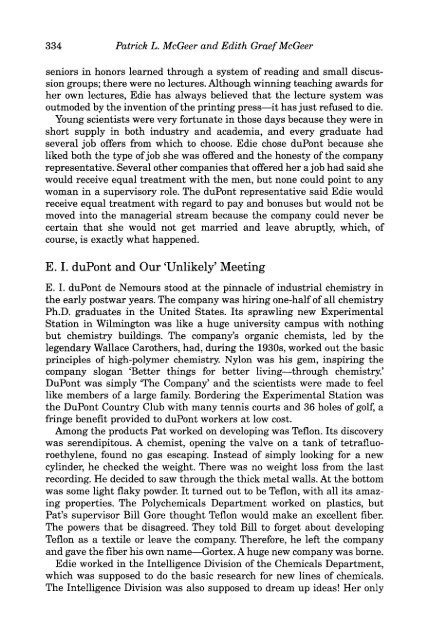Edith Graef McGeer - Society for Neuroscience
Edith Graef McGeer - Society for Neuroscience
Edith Graef McGeer - Society for Neuroscience
Create successful ePaper yourself
Turn your PDF publications into a flip-book with our unique Google optimized e-Paper software.
334 Patrick L. <strong>McGeer</strong> and <strong>Edith</strong> <strong>Graef</strong><strong>McGeer</strong><br />
seniors in honors learned through a system of reading and small discussion<br />
groups; there were no lectures. Although winning teaching awards <strong>for</strong><br />
her own lectures, Edie has always believed that the lecture system was<br />
outmoded by the invention of the printing press—it has just refused to die.<br />
Young scientists were very <strong>for</strong>tunate in those days because they were in<br />
short supply in both industry and academia, and every graduate had<br />
several job offers from which to choose. Edie chose duPont because she<br />
liked both the type of job she was offered and the honesty of the company<br />
representative. Several other companies that offered her a job had said she<br />
would receive equal treatment with the men, but none could point to any<br />
woman in a supervisory role. The duPont representative said Edie would<br />
receive equal treatment with regard to pay and bonuses but would not be<br />
moved into the managerial stream because the company could never be<br />
certain that she would not get married and leave abruptly, which, of<br />
course, is exactly what happened.<br />
E. I. duPont and Our 'Unlikely' Meeting<br />
E. I. duPont de Nemours stood at the pinnacle of industrial chemistry in<br />
the early postwar years. The company was hiring one-half of all chemistry<br />
Ph.D. graduates in the United States. Its sprawling new Experimental<br />
Station in Wilmington was like a huge university campus with nothing<br />
but chemistry buildings. The company's organic chemists, led by the<br />
legendary Wallace Carothers, had, during the 1930s, worked out the basic<br />
principles of high-polymer chemistry. Nylon was his gem, inspiring the<br />
company slogan 'Better things <strong>for</strong> better living—through chemistry'<br />
DuPont was simply The Company' and the scientists were made to feel<br />
like members of a large family. Bordering the Experimental Station was<br />
the DuPont Country Club with many tennis courts and 36 holes of golf, a<br />
fringe benefit provided to duPont workers at low cost.<br />
Among the products Pat worked on developing was Teflon. Its discovery<br />
was serendipitous. A chemist, opening the valve on a tank of tetrafluoroethylene,<br />
found no gas escaping. Instead of simply looking <strong>for</strong> a new<br />
cylinder, he checked the weight. There was no weight loss from the last<br />
recording. He decided to saw through the thick metal walls. At the bottom<br />
was some light flaky powder. It turned out to be Teflon, with all its amazing<br />
properties. The Polychemicals Department worked on plastics, but<br />
Pat's supervisor Bill Gore thought Teflon would make an excellent fiber.<br />
The powers that be disagreed. They told Bill to <strong>for</strong>get about developing<br />
Teflon as a textile or leave the company. There<strong>for</strong>e, he left the company<br />
and gave the fiber his own name—Gortex. A huge new company was borne.<br />
Edie worked in the Intelligence Division of the Chemicals Department,<br />
which was supposed to do the basic research <strong>for</strong> new lines of chemicals.<br />
The Intelligence Division was also supposed to dream up ideas! Her only











![[Authors]. [Abstract Title]. - Society for Neuroscience](https://img.yumpu.com/8550710/1/190x245/authors-abstract-title-society-for-neuroscience.jpg?quality=85)





